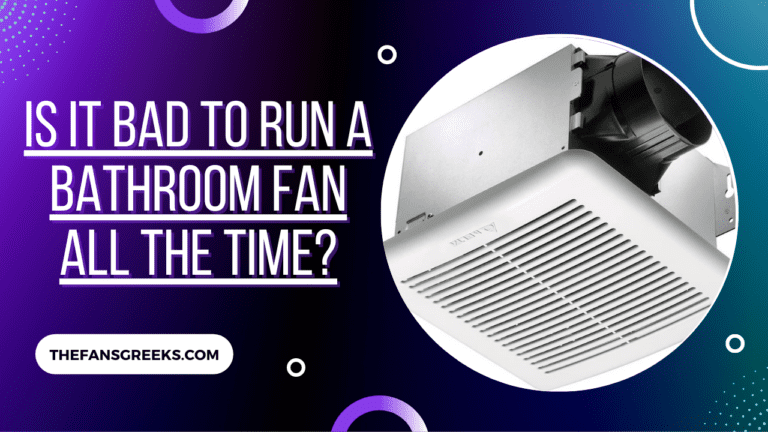9 Ways to Stop Condensation in Your Bathroom Fan
Condensation and moisture are often associated. Suppose your bathroom fan becomes overwhelmed by condensation instead of removing it. In your bathroom fan, condensation can accumulate in many ways.
Taking a bath or shower creates moisture. Bathroom fans will develop condensation if they are not turned on or not run long enough. Condensation can be removed by cleaning and maintaining your HVAC system.
However, this problem cannot be solved in a one-size-fits-all manner. As a result, different solutions are required for different causes. Your bathroom fan may be leaking water. Make sure this problem is resolved before it causes water damage or mold.
Why Is There Condensation in Your Bathroom Fan?
If you have water on a cold surface, such as your walls or window sills, and moist hot air, such as your shower steam, you will have condensation. Condensation is more prevalent when people take long hot showers or baths. It is usual for your bathroom to have condensation, but too much condensation on your bathroom fan could be harmful.
Depending on its strength and operation, the fan may not be able to handle all the condensation generated by your bathroom. It may also be unable to do its job because you don’t run it long enough. It is also possible for your fan to accumulate water due to poor insulation and ventilation.
However, condensation on your bathroom fan typically indicates some kind of problem that, if not addressed, could damage your fan or result in a large repair bill due to mold or water damage.
How to Stop Condensation in Your Bathroom Exhaust Fan
Cleaning and Maintenance
Keeping your bathroom fan clean and maintained reduces condensation and unclogs dust and debris. Remove the cover of your bathroom fan and clean it with rags, a small brush, or compressed air after removing the cover. Any condensation on your bathroom fan can also be removed with a clean, dry cloth.
Running Your Bathroom Fan Longer
It may be that your bathroom fan is not running long enough, which is causing your issue. Most moisture and condensation can be removed from your bathroom by running a fan for 30 minutes. The moisture and condensation will not be removed from your shower if you run it excessively for a long period of time.
Your bathroom fan should be turned on for a couple of hours in that case. Do not use your fan overnight as it will not remove any moisture, and overworking the motor will probably cause it to overheat and possibly cause an electrical fire.
Clearing Clogged Vents
Occasionally, your bathroom vents can become clogged with debris. A clogged bathroom fan is debilitated and unable to do its job when these vents become clogged. Condensation and moisture will accumulate if your fan doesn’t have an open vent.
This type of vent is usually clogged with leaves and other outdoor debris. A roof vent or an exterior wall vent can usually be found outside. Once the vent’s cover or screen is removed, you can clean it out.
Checking Your Insulation
The attic and walls of your home can be poorly insulated, resulting in a colder bathroom. During a hot shower or bath, condensation will be more likely to form in a cold bathroom. Insulation may need to be added, or you may need to replace it if it is old or of poor quality.
Replace the Ventilation Hose
Your fan’s airflow is connected to the outside vent by the bathroom vent hose or ductwork. The ductwork can suffer from tear damage and too many bends, the most common of which is tear damage. It’s possible for condensation to form on your fan when your ductwork has too many bends in its path. Your ductwork may need to be straightened or replaced.
Heat Your Bathroom
Your bathroom can be heated one to two hours before you use it if you have a heating system or even a plug-in heater. Before starting your shower or bath, make sure your bathroom is already warm. Consequently, condensation will not occur. It takes longer for your heater to warm up the bathroom enough to prevent condensation during the cold winter months.
Buying a Better Bathroom Fan
You might have to upgrade your bathroom fan if you want to remove moisture and condensation. The additional showers and baths might strain your fan if your household has grown. A bathroom fan’s CFM number should be taken into consideration when shopping.
A fan’s capacity for sucking in the air can be measured by its CFM (Cubic Feet per Minute). You should choose a fan whose CFM is at least as high as your bathroom’s square footage.
Ventilate Your Bathroom
Condensation and moisture levels can be reduced with proper ventilation. Opening a window is all it takes to ventilate your bathroom. A household fan or leaving the bathroom door open are other options if your bathroom does not have windows. Dehumidifiers can also reduce humidity and remove condensation.
Use a Condensation Trap for a Bathroom Fan
These traps are usually PVC and installed between the outside vent and your fan. There is no doubt that these condensation traps work as advertised. As a result, they prevent condensation from entering your bathroom fans through your ducts and vents.
The installation of condensation traps is easy and inexpensive. They will not solve all condensation problems but work well for vents and ducts.

![Bathroom Fan Stopped Working (Won’t Turn On) [FIXED]](https://www.thefansgreeks.com/wp-content/uploads/2022/08/Bathroom-Fan-Stopped-Working-Wont-Turn-On-FIXED-768x432.png)



![How to Clean NuTone Bathroom Fan [Step-by-Step Guide]](https://www.thefansgreeks.com/wp-content/uploads/2022/08/How-to-Clean-NuTone-Bathroom-Fan-768x432.png)
